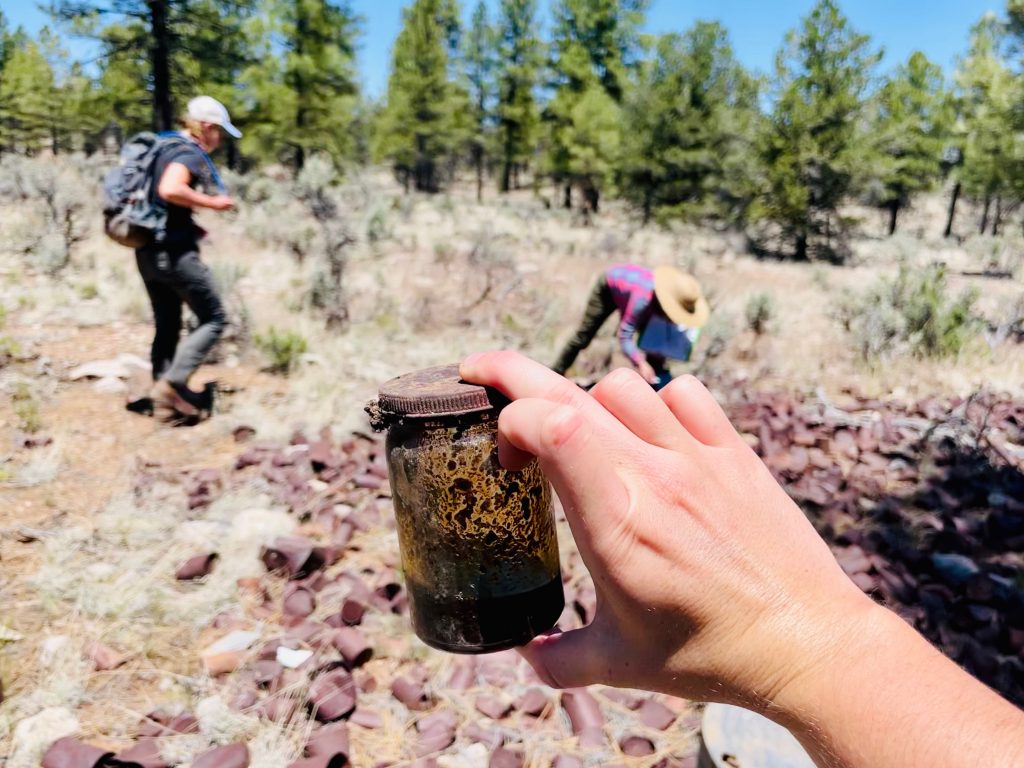In the 1930s, the Apex logging camp outside of Tusayan was bustling—with more than a hundred men hard at work on the Grand Canyon railroad, women cooking and managing homes and children playing and attending the newly-built schoolhouse.
Now, all that’s there is the building remains and trash they left behind. But those remnants tell a story, one that historical archeologist Emily Dale, lecturer in NAU’s Department of Anthropology and field director of the Apex Archeology Project, and her eight students from throughout the country are helping to unfold.
“I wanted to build a program that not only allowed students to learn real-world archeological skills, but also catalog the historical archeology in the region and learn more about what life was like in Arizona during the Great Depression,” Dale said. She partnered with the Kaibab National Forest to set up NAU’s first archeological field school at the Apex camp—where students get invaluable experience while earning college credits.
“I’m enjoying every part of it,” student Andrew Emmett Kwinna Naranjo said. A descendent of the Moapa Band of Paiutes and now working as a tribal consultant, he enrolled in ANT511 to understand more about the process of historical archeology. He hopes to bring what he learns back to his tribe in Las Vegas, teaching members how to document and log the artifacts found on the reservation. “It’s a great experience and I think everybody should have some kind of experience like this, just as far as developing yourself as a person.”
For one month during the summer, Dale and her team spend roughly eight hours a day at the Apex site, digging through remains and piecing together the puzzle that is this logging camp.
“One of my first finds was part of an Orange Crush bottle,” said Eva Parra, who graduated from the University of Arizona last year and enrolled in NAU’s field school to get some hands-on experience before searching for an archelogy job. “It’s funny because when you think of Orange Crush, you think of junk food, but this piece of glass I found was absolutely beautiful. After I found the one piece, I started seeing them everywhere.”
Dale’s favorite find so far? Part of an old radio.
“One of the students was able to look up a YouTube video of someone who has the same 1926 radio, and we were able to listen to some of the music together and sort of envision the camp being alive.”
The students have been at the camp since May 31 and have already unearthed hundreds of items to catalog: ceramic pieces with ornate designs; sardine cans; rubber soles of shoes; part of a light bulb; tobacco tins; alcohol bottles; stoves; pots and pans; railroad spikes; combs; a harmonica reed plate; children’s toys; and part of what Dale believes to be a pharmaceutical bottle with “Babbitt Inc.” on the bottom.
“We’ve found a lot of things made in Japan, but it’s the local connections that help us understand that this wasn’t just a rural wood-cutting camp, it’s connected to The Grand Canyon, it’s connected to Williams, it’s connected to Flagstaff, and is all part of a larger nexus of people living and still working during the Great Depression in northern Arizona.”
Parra believes that historical archeology is important because it gives glimpses into the past and allows relics, like those found at the Apex camp, to better define people of the past.
“Written records can only tell us so much about history. What people leave behind verses what people write down is so different,” they said. “You don’t see journal entries from this time period that mention loving Orange Crush, but this site, their trash, tells us they do. As a person, I think there’s a lot of value in understanding people, and part of understanding people is understanding our history.”
“Learning history of anybody’s history helps you understand who you are. So, I think that’s a great thing,” Naranjo said.
Carly Banks | NAU Communications
(928) 523-5582 | carly.banks@nau.edu




